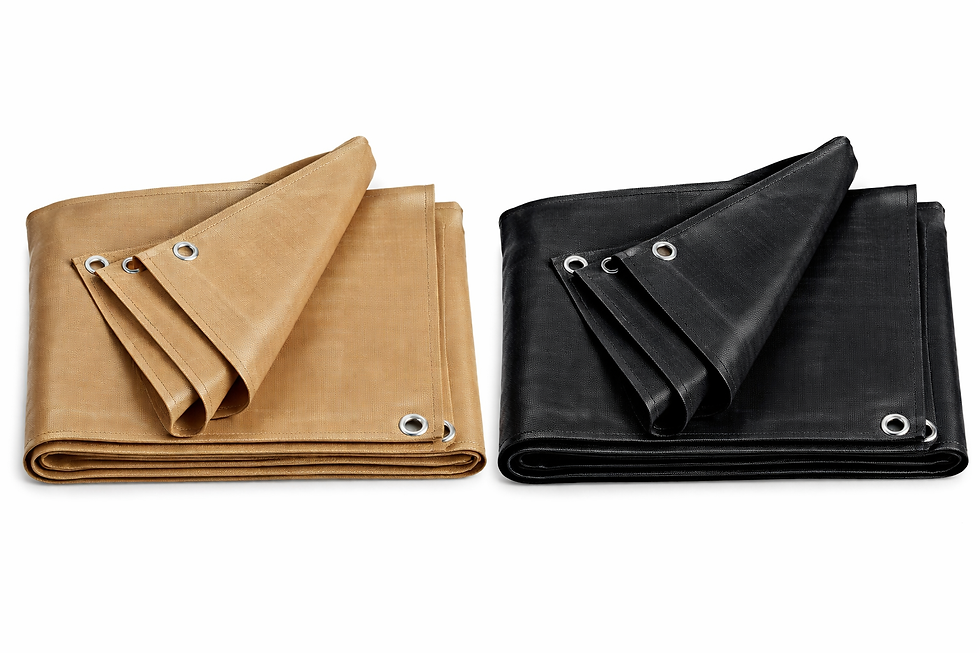The Evolution of Plastic Tarpaulin Sheet
- Bradley Tomlinson

- May 22, 2024
- 3 min read
Updated: May 23, 2024
Plastic Tarpaulins, for the most part known by the shorthand of "tarps," are multipurpose apparatuses used in numerous industries and by homeowners these days. Anyway their origins return to the straightforward human interactions of loved ones. The primary tarps were produced using waterproofing canvas or material firmly gotten to the fabric with stick like wax, oil and other sealants. They were large, awkward and subsequently, intensely reliant upon shipping and transportation organization. Plastics like vinyl and polyethylene were created in the right on time to mid 1900s. The makers who made these materials started conducting analyses to see what new purposes they could come up for waterproof materials like tarps.
Vinyl tarps as the game changers
In the 50s tarps from vinyl began gaining notoriety since they were less expensive and lighter contrasted with the weighty canvas tarps coming from these days. One of the principal vinyl tarps to be mass-created in history was finished by BF Goodrich Organization in 1952. Indeed, even the primary weighty and to some degree solid vinyl tarps were superior to canvas and more reasonable. These tarps actually served for a decent term. All through the 60s and 70s the innovation behind the once-unbending vinyl tarps took a major jump with substance organizations creating more flexible vinyl and PVC formulas. One of the superb components of the last part of the 1970s vinyl film is the way that the vinyl tarps had become thinner and more flexible. This indirectly permitted them to be moved practically anyplace.
Rise of the Poly Tarp
Back in the mid 80s, polyethylene tarps (alluded to as poly tarps available), which were an ideal substitute for vinyl, were quick to be introduced. In contrast to vinyl, poly tarps didn't have a similar adaptability however it was a truly solid item that was substance safe and practical. Because of their waterproof highlights, they are decay proof and can withstand settings of drawn out sunshine without their quality degrading. Along these lines poly tarps were famously used as rock solid truck tarps and horticultural tarps.
The innovation of tarp materials and manufacturing procedures exists at this moment. A few instances of more up to date materials utilized for the tarp series include polypropylene, which is areas of strength for very; covered polyesters which are explicitly intended to take care of superior execution needs; and mixed fabrics, for example, vinyl and polyester which structure a composite. The ongoing assortment of tarps with extra exceptional properties like imperviousness to fire, tear opposition, and it are additionally accessible to reflect capacity.
Advancements in Tarp Manufacturing
Additionally, what is worth focusing on, is that the techniques of manufacturing Tarps have progressed at similar rate as the material enhancements. Initially, pieces were assembled as they were slipped a few times into lines. This could make these breaks or tears the creases. Our most recent welding procedures that weld electron tarps together into one unit will ensure their sturdiness and powerful waterproofing. Moreover, there are new fabric-cut machines for minimizing waste and maintaining standard sizes of the tarpaulins coming off the assembly line.
Tarps for What's in store
The future, most likely, will observer more advancement with regards to plastic tarp innovation. A few areas where we might see upgrades include: A few areas where we might see enhancements include:
Self-smart and intelligent tarps that have sensors for monitoring conditions or remotely causing activities that involve releasing rainwater.
Production of fabric biodegradable casings from plant-based or recyclable plastics in the bid for ecological sustainability.
Unbelievably stretch and flexible tarps that can firmly cover the round burdens like the roughage baskets or the heap of fleece.
Tarps integrate solar panels for the stock of power or solar thermal gatherers to tackle thermal energy.
Conclusion
However, Heavy Duty Tarpaulin, the plastic type of tarps, has developed such a great amount after the greater part a long time. These, obviously, have begun from their ancestors, canvas and wax material. As we count down to the following a long time since the invention of dispensable facial coverings, we are left with a feeling of excited expectation about what other material science and manufacturing leap forwards will bring in other places for this humble yet valuable piece of plastic defensive sheets.









Comments